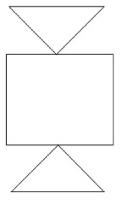Activity 3: Writing a literary interpretation
In this activity you will use the information in your story maps and your thesis statements to write a literary interpretation.
Key inquiry question: How do writers use literary codes and conventions to create meaning?
Refining the thesis statements
Your thesis statements should provide an outline of how the author communicated their message and will be used as the structure for your literary interpretation. It takes quite a few drafts before refining the final road map. This is important, because what it says and how it is structured will guide the rest of your writing on the topic. Sometimes it helps to see that your thesis statement is really an answer to a question.
- Re-read each short story and answer the questions below:
- How does author, Catalina Rembuyan, build reader sympathy in Angry?
- How does author, JC Martin, use character, plot and dialogue in Hantu: a Malaysian ghost story to build dramatic tension?
- What does, Sabrina Abu Abu Akar, tell us about Islam and Malaysian life in The stalker within?
- What message is author, Timothy Nakayama, trying communicate through his unusual use of plot, character and symbols in his story Rats and cats?
- Use these answers to add to and refine your thesis statements.
- Form a group of four people to work together to improve each person's thesis statements.
- One person in the pair or group should go online to PrimaryPad.

- Click on 'Create Pad.' Once the new page loads, find the URL or web address for your page and share this with those who will help you revise the thesis statement.
- Each person in the pair or group should paste or type in the thesis statements they want assistance with.
- Once each person has their own best version typed or pasted into PrimaryPad, the helpers can take turns editing each other's work. Notice that each writer has their own colour so it becomes clear who is editing whom at any given time. If it helps to identify yourselves, each person can enter their names in the 'user' field located under the top right 'Users' icon. You will find this a great tool.

- Take enough time so that everyone has had a chance to edit or refine each thesis statement. Do you think that others' ideas have actually made your thesis statement worse? Or perhaps it was improved by one person and then someone later made it unclear? Use the 'Timeslider' feature to playback the whole editing session! Just drag the editing point (the blue arrow) back to the beginning then click the 'play' button.

Drafting your literary interpretation
You might already have a very good process for composing essays. If this is the case, please use the structure and approach that you have found most effective. Alternatively, you could use a common and helpful essay shape shown on the right. The three sections represent the introductory paragraph, the body paragraphs and the concluding paragraph.
The introduction transitions or funnels down from a general, attention-grabbing opening to the point of your thesis statement.
The body paragraphs begin with a 'stem' from your thesis statement. This is one of the parts you listed, such as character, symbol or plot, and they all follow with a paragraph for each in the same order you listed them in the thesis statement. Follow this topic sentence of the paragraph with evidence from the story, such as references or quotations that support your opinion, then give commentary of your reasons why this 'proves' your thesis. Write at least two paragraphs.
The concluding paragraph is short and basically is like the introduction, but upside down. Begin with a reworded version of your thesis statement. If you write the exact same thing as your thesis statement from the introductory paragraph that is okay, but pretty boring. So a little rewording is good, just don't change the order or your main opinion. You can stretch it out to a couple sentences if you like. Then return to what you used as your attention-getter – this gives the reader a sense of closure. Finally, because these authors have written about significant things that relate to all human beings, finish with a statement that shows how their message can apply to everyone as a universal truth.

You can download Shaping your essay (PDF 61 KB) that more graphically explains all this as well as the Evaluation rubric for literary interpretation (PDF 48 KB).
Choose the essay format you find most helpful and then:
- Select the short story you wish to focus on and use the thesis statement to create your literary interpretation.
- You might want to review and highlight sections that you will use as supporting evidence from the works. You can do this either from a Diigo account using the highlighting tool; copying and pasting the story into a document that you can then highlight; or by printing out a hard copy of the story and highlighting manually.
- Use word processing software to outline your essay. You can paste your thesis statement at the end of the first paragraph, divide out the 'stems' as topic sentences for the body paragraphs and reword sections for the conclusion. Or you can start from the beginning and write straight through to the end.
- Complete your draft. Reread it. Compare it to the evaluation rubric. Use your word processor to make revisions based on what you learned from using the evaluation rubric. Share your essay with a friend and help each other with things like coherence, evidence and explanations.
- Consider publishing your finished literary analysis on a school blog or other platform!